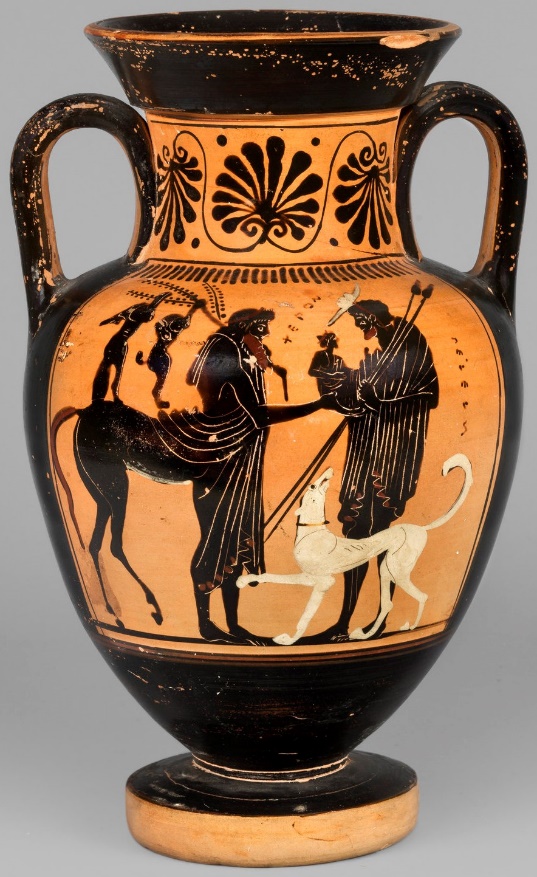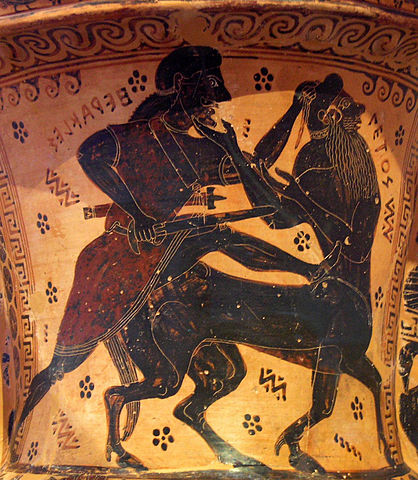Centaur
Five mentions:
— Book 2 Canto 3
— Book 5 Canto 1
— Book 5 Canto 3
— Book 6 Canto 1
The poison of the world has stained his throat
— Book 6 Canto 1
Centaurs are depicted in the primitive tradition as men having the belly and hindquarters of a horse.
Centaur Chiron. National Museum in Warsaw. Public domain
They represent the seekers who are ‘propelled’ by a very strong vital energy. For the Greek poet Pindar, they are similar ‘to their mother in the lower part, and to their father in the upper part’, a description that probably led to their most common representation in which the front legs are also those of a horse.
Herakles wrestles down the Centaur Nessos. National Archaeological Museum of Athens, CC BY-SA 2.5 Μαρσύας Own work, 2005.
With the exception of one, Chiron, the Centaurs are the result of the union of the hero Ixion with a cloud – an eidolon – of Hera.
The name Ixion means ‘a perception of truths by identity’. He represents a fairly advanced seeker who has reached the overmind and seeks to achieve a total union with the divine in spirit.
The story of Ixion can be summarised as follows: Ixion was guilty of perjury and even of an awful act amounting to a crime against a blood relative. No one could redeem him. Finally, Zeus took pity on him and purified him. Ixion was even allowed to share the delightful abode of the gods. But Ixion ‘showed himself to be extremely ungrateful, and not being able to sustain the excess of his happiness for long, he conceived in his blind delirium a furious passion for Hera, whom only the bed of the great Zeus is worthy of receiving’. Hera complained about this to her husband, Zeus. Zeus then fashioned a cloud in the image of his wife, and it was with this ghost that Ixion united. From this union was born a son, Centauros. And it was he who, mating with the wild mares from Magnesia, became the father of the Centaurs.
Ixion is thus the image of a fairly advanced seeker who has gone astray but finds the right path again. He may enjoy some of the powers that come with first access to the overmind, ’the delightful life of the gods’.
However, he thinks he is already at the end of the Yoga and deems himself much more advanced than he actually is. Indeed, if he has achieved a certain ascent to the overmind in the planes of the spirit, it is by rejecting life and imposing from above a mastery over the external nature which is not yet transformed. This is the meaning of his having the body of a horse as his lower part. Indeed, when Centaurs drink wine, they lose all control and their true nature comes to light.
In a way, it can be said that the Centaurs reflect some of the highest achievements of the ancient yoga – the yoga in the sense of Sri Aurobindo, i.e. the teachings and practices that have been preserved in various spiritual traditions to the present day. In spite of their powerful achievements, they show a certain spiritual pride in the sense that they think they are already at the summit of all the possibilities of the overmind and represent the highest point of human evolution.
In the progressive movement of purification, the attachment to these achievements will have to be abandoned: that is why in the myths the Centaurs are eventually hunted down by Heracles and by the Lapiths.
But there is an exception among the Centaurs, Chiron, who was not born of Ixion but of the Titan Cronos united with the nymph Philyra, ‘she who loves right evolution, the evolution according to the divine plan’, and therefore a symbol of a realisation in humility. Chiron is described by Homer as ‘the most righteous of the Centaurs’ (Iliad, xi. 831).
Raised by Apollo, the god of higher light, Chiron excelled in many arts, especially in the art of healing, i.e. the ability to reharmonise.
His name means ’the hand’, implying that these reharmonising powers used his hands as a tool to transmit divine energies.
The son of Cronos, he has the rank of a god and is therefore immortal. He symbolises the high achievements of ancient yoga accomplished in humility and total surrender.
Sri Aurobindo is thus referring to the powerful realisations of the ancient Yoga which were achieved through the mastery of nature imposed by the mind and personal will.

